16 Mammals II / Marsupials
Learning Objectives
- Describe unique anatomy and physiology of ferrets, rabbits, hedgehogs, and sugar gliders
- Describe sexing of the above species
- Describing housing considerations for the above species
- Describe control of diseases and parasites for the above species
- Describe normal behaviors for the above species
- Describe nutrition for the above species
- Describe dentistry for rabbits and ferrets
*
 Ferrets
Ferrets
California and Hawaii prohibit importation and possession of ferrets as pets. Other states may require special permits. Some local governments prohibit ownership of ferrets including New York City, Dallas/Fort Worth, and Washington, DC. Potential owners should check local and state laws before adopting or purchasing ferrets.
Unique Anatomy and Biology
Biology of Ferrets
| LIFE SPAN | 5-8 years |
| TEMPERATURE | 100.0-104.0°F (38-40°C) |
| PULSE | 180-250 beats per minute |
| RESPIRATION | 33-36 breaths/minute |
| REPRODUCTIVE MATURITY | 6-12 months; virtually all pet ferrets in the United States are neutered |
Ferrets are mustelids, with long, lean, slender, muscular bodies with short legs. Ferrets have oval-shaped heads and pointed snouts. Their ears are small and rounded. Ferrets have bright, clear eyes, but their sight is not well-developed. They have highly developed senses of hearing, smell, and touch. Both sexes develop a strong musky odor at maturity. Spaying or castrating, along with removal of the anal glands, can help reduce the odor; virtually all ferrets available for sale as pets in the United States are spayed / castrated. Glands in the skin also cause a musky scent.
Ferrets are unable to sweat and use changes in body posture in the environment to dissipate body heat. The fur of ferrets is dense and very soft. They change coats completely twice a year.
The heart is connected to the sternum with a ligament that often contains fat, which gives the heart a raised appearance on a lateral radiographic view. The trachea is large and the lung capacity is increased, with an increase in airway length commensurate with total body length. The intestinal tract is relatively short and the liver is relatively large.
Sex identification in ferrets is as in dogs. Male ferrets (hobs) have a penis on the ventral midline of the abdomen; the penis contains a small bone, the os penis. Female ferrets (jills) have a vulva caudal and ventral to the anus. Males are usually about twice the size of females, with the average male weighing 2.2-4.4 lb (1-2 kg) and the average female weighing 1.1-2.2 lb (0.5-1 kg). Ferrets are about 18” (45 cm) in length.
Specifics of anatomy and other information about ferrets can be found in the Manual of Exotic Pet Practice, pp 345-374.
Housing
An indoor cage can be provided, preferably with a solid or wire floor and wire sides, not glass. Ferrets can be housed individually but ideally are housed in pairs or groups. Ferrets need a place to hide and sleep and a place to urinate / defecate. Ferrets can be taught to use litter boxes. They prefer relieving themselves in corners. A litter box should be placed in the corner of the cage away from the food and sleep areas. Whenever left out of the cage, a litter box should be available in the room.
Ferrets are curious and can get into surprisingly small spaces. If ferrets are permitted to roam free, areas that should be blocked off include behind large appliances or immovable pieces of furniture and inside recliners.
Ferrets can be maintained outdoors but cannot tolerate temperatures below 20°F or above 90°F (< -6°C or above 32°C).

Vaccinations and Disease Control
Ferrets should be vaccinated against canine distemper virus and rabies virus. Specific vaccines approved for use in ferrets are available in the United States. Ferrets are vaccinated against distemper no earlier than 8 weeks of age, and again at about 12 and 16 weeks of age, and then annually. Ferrets are vaccinated against rabies at 12-16 weeks of age and then annually. Vaccines can be given subcutaneously; some municipalities require that rabies vaccines be given intramuscularly.
Ferrets have non-retractable claws that require regular trimming.
Parasite Control
Intestinal parasites are uncommon in pet ferrets. Ferrets presenting with diarrhea should be checked for coccidia and Giardia sp. and treated appropriately. Ferrets housed outside may become infested with fleas; diagnosis and treatment is as in other species. Ferrets also can pass ear mites between themselves. These are evidenced by presence of heavy brown discharge in the ears, which can be examined microscopically to identify the mites. The ears are cleaned and treated topically. Ferrets housed outdoors also may be more susceptible to heartworm, as it is carried by mosquitoes. Advantage Multi is a parasite control product recently approved by the FDA for use in ferrets that can be used as a heartworm preventative.
Behavior
Ferrets are not nocturnal but do sleep about 75% of the time. Ferrets have tough skin and while playing often bite one another. This playful bite can be painful to humans. Discipline for play biting should include a firm “no” until the ferret learns the behavior is not acceptable. As described under housing, ferrets are curious and should be carefully supervised when not enclosed. Enrichment is an important component of housing to promote normal behaviors.
Dentistry
Ferrets will develop dental tartar with subsequent gingivitis. This may be more common in ferrets fed primarily a soft diet and should be addressed with a dental cleaning by a veterinarian.
Biosecurity
Good general hygiene should offset any concerns about passage of disease from pet ferrets to humans. Ferrets are susceptible to influenza, so humans sick with the flu should avoid contact with their ferrets until they are no longer contagious. Ferrets are considered to be more susceptible to infection with COVID-19 than many other species but the CDC does not consider ferrets to pose a significant transmission threat to humans.
Nutrition
Ferrets are carnivores. Ferret food should be high in animal protein (30-40%), high in fat (18-30%), and low in fiber. Dry commercial ferret food is recommended. If a commercial ferret food is not available dry kitten chow can be used. Regular dog and cat chow, which often contains a high percentage of plant-based protein, should be avoided. Treats should be given in moderation and should be meat-based. Meat baby food, cooked meat scraps, jerky, and cracklings are appropriate. Although ferrets love raisins, dates and other sugary treats, they should not be given to ferrets because they promote tooth decay and can lead to pancreatic dysfunction. Bones should never be given as treats. Ferrets prefer to eat multiple small meals per day and will hide excess food.
Ferrets require about three times as much water as dry matter. Fresh water should be offered in more than one location and, ideally, in more than one manner. For example, water may be offered in a sipper bottle in the cage and in a crockery bowl elsewhere.
*
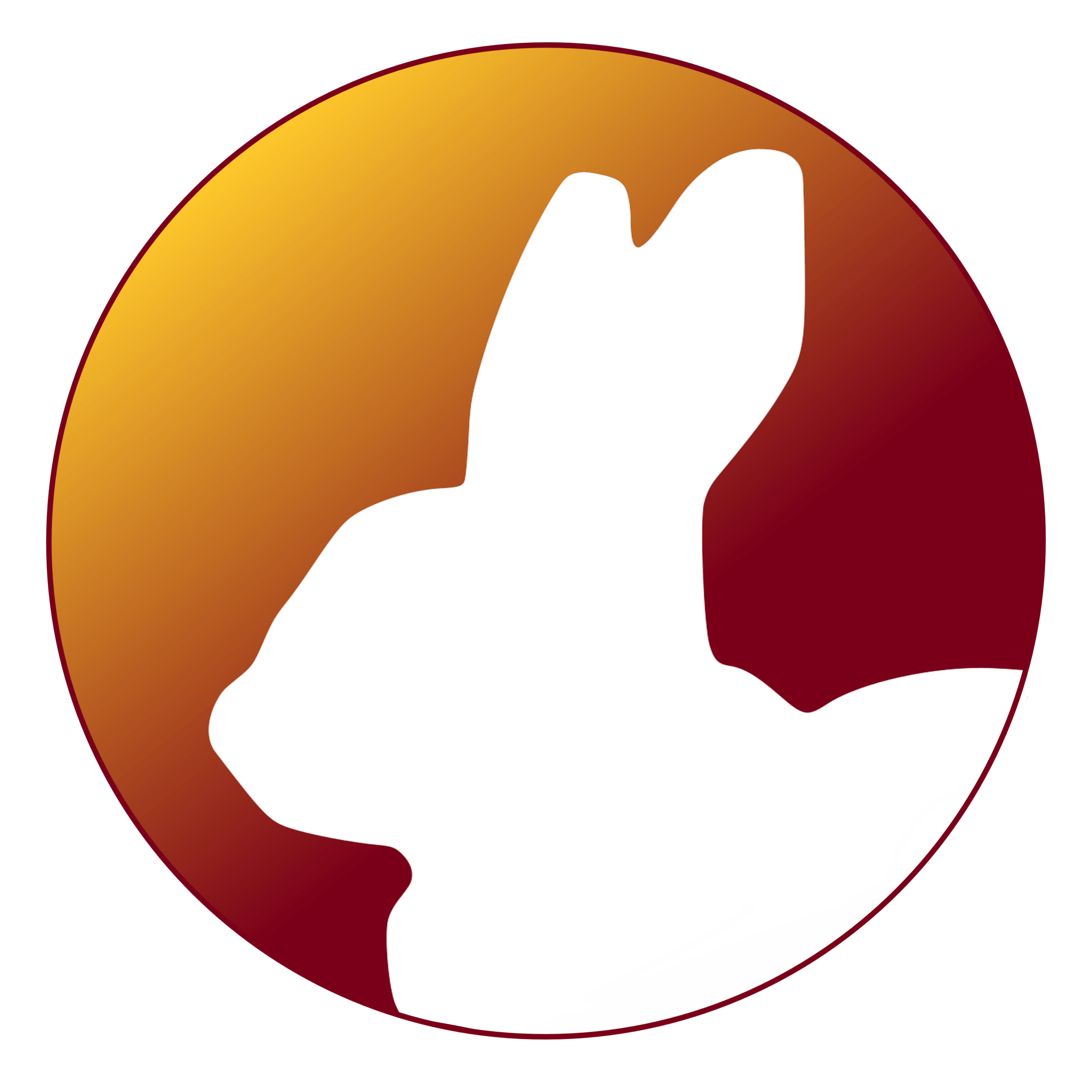 Rabbits
Rabbits
Unique Anatomy and Biology
Biology of Rabbits
| LIFE SPAN | 6-13 years |
| TEMPERATURE | 100.0-103.0°F (38-39°C) |
| PULSE | 130-325 beats per minute |
| RESPIRATION | 32-60 breaths/minute |
| REPRODUCTIVE MATURITY | ♀ and ♂ sexual maturity 4-5 months for small breeds, 5-8 months for large breeds |
There are many breeds of rabbit. Rabbits can be classified by size, by fur type, or by body type. Small breeds, those weighing less than 4-5 lb (2 kg), include the Netherland dwarf, mini-lop, and Dutch breeds. Medium breeds, those weighing 5-10 lb (2-5 kg), include the rex, English, Angora and Belgium breeds. Large to giant breeds are those weighing more than 10-11 lb (5 kg) and include New Zealand whites, English lops, British giants, and Flemish giants. Body types also can be used to classify breeds of rabbit. The commercial body type is most commonly seen in production and meat animals. These rabbits grow fast and tend to have large meaty loins. An example of this type is the New Zealand. The compact body rabbits are similar to the commercial type, only smaller. Example breeds are the American fuzzy lop and the small or dwarf breeds. There is only one representative of the cylindrical body type recognized by the American Rabbit Breeders Association, the Himalayan. The British Rabbit Council also recognizes a second breed, the Vienna. Cylindrical shaped rabbits show a straight top line with no arch. The profile shows no taper. Fully arched rabbits are built for agility and speed and resemble hares, which is where most of the bloodline comes from. The arch starts at the neck and goes right down to the tail. When viewed from the side, there’s space under the belly. The semi-arch body type is common in the largest of rabbit breeds including the Flemish giant.
Rabbits have very delicate skin that can easily be torn when clipping, as for pre-operative preparation. Rabbits do not have footpads but instead have thick fur on their feet to protect them from the environment.
Rabbits’ large ears are used for hearing and for thermoregulation. Rabbits have good vision but cannot see directly below their nose, relying on their stiff whiskers to identify things in the area of their mouth. Rabbits are obligate nose-breathers and have a relatively small thoracic cavity.
The skeleton of rabbits is very light and they are very muscular. This predisposes them to vertebral injury and long bone fractures. Unlike rodents, rabbits have four maxillary incisors, two large central incisors with two smaller incisors, the peg teeth, behind them. Dentistry is described below.
The large cecum of rabbits provides anaerobic fermentation of plant foods; the cecum has a capacity roughly ten times that of the stomach in rabbits. Cecal pellets are passed through the rectum and immediately re-ingested for further breakdown (coprophagy). Rabbits excrete excess calcium through the kidneys and so may have turbid urine. Color of the urine varies from yellow to red, depending on their diet.

Sex Identification in Rabbits
Sex identification is by protrusion of the penis in males. Hold the rabbit as shown below. Hold the tail with two fingers and put pressure beneath the anogenital orifice with the thumb. Pull on the tail gently but firmly and press downward on the area of the vent.
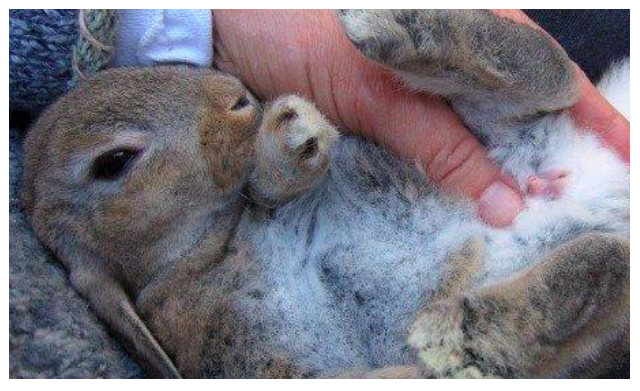
In the picture below, the tubular structure with a circular opening is the penis. In adult males, there also will be grayish areas running parallel to the long axis of the bunny on either side of the vent; these are the scrotal sacs. Inguinal canals are open throughout the male rabbit’s life, so the testes can readily be drawn back into the abdomen.
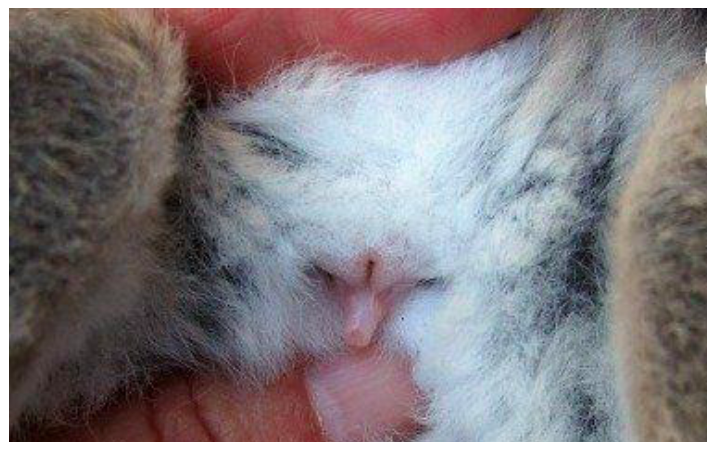
The picture below is a doe; pressure on the vent causes minimal protrusion of tissue, with a slit on it.
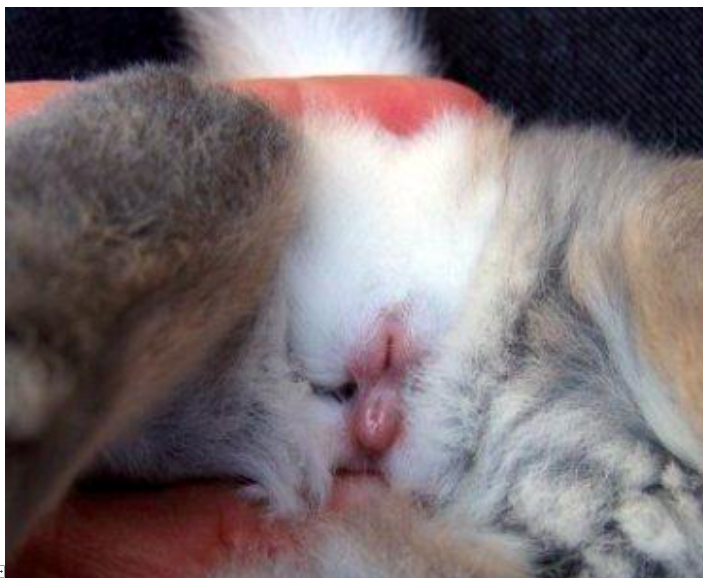
Specifics of anatomy and other information about rabbits can be found in the Manual of Exotic Pet Practice, pp 375-405.
Housing
The size of the hutch depends on the size of the rabbit and should include areas for sleeping, eating, and urination / defecation. Rabbits can be housed alone but ideally are housed in pairs or groups. If rabbits are to be housed in the hutch with no outdoor exercise, the hutch must also be large enough to permit the rabbit to exercise within it. The cage should be tall enough for the rabbit to sit upright without its ears hitting the top of the cage. Wire cages, including wire floors, can be used for most breeds, however, heavier rabbits should be kept on solid floors to prevent injury to the feet. Wire mesh should be an appropriate size to ensure that the rabbit’s toes are not caught within mesh on the floor. All cages should include an area of solid flooring for resting. Hutches with solid floors where the rabbit will directly contact the bedding should contain timothy or grass hay, or another absorbent material. Wood shavings generally are not recommended. Urine and feces should be cleaned from the hutch daily and completely fresh bedding provided once or twice weekly. Rabbits can be trained to use a litter box. Fresh water should be available at all times in a sipper bottle or heavy crockery dish that cannot be tipped.
Rabbits are best housed at an ambient temperature from 60-75°F and humidity from 30-60%. They can tolerate colder temperatures if acclimatized and provided an enclosed shelter, however, they do not tolerate heat well.
Vaccinations and Disease Control
There are no vaccines recommended for control of infectious disease in pet rabbits in the United States. Vaccines exist for myxomatosis (vaccine currently not available in the United States) and rabbit hemorrhagic disease but are not recommended for routine use.
Parasite Control
The most common internal parasite of rabbits is coccidia, of the Eimeria sp. These can be diagnosed on fecal examination and treated as in other species. Rabbits housed outside may become infested with fleas; diagnosis and treatment is as in other species. Ear mites also are common if the hutch is at ground level as the rabbit may have contact with wild rabbits.
Behavior
Rabbits prefer to eat in the afternoon and evening and should drink a fair amount of water every day, up to 100 ml/kg/day. Rabbits unsupervised indoors will chew and may damage furniture and woodwork or chew on electrical cords.
Male rabbits kept together may fight. Female siblings maturing together show less aggressive behavior towards one another than other rabbits. When fearful or aroused, rabbits may thump with one rear foot and may spray urine. Rabbits may pull fur from themselves or others and chew it. Fur-chewing is thought to be caused by boredom, a low fiber diet, or some unidentified nutritional deficiency. Increasing fiber seems to be effective in preventing fur chewing. Enrichment is an important component of housing to promote normal behaviors.
Dentistry
Rabbits are predisposed to dental disease by congenital malocclusion or by poor diet, without adequate wear on the continuously erupting incisors. Signs of dental disease include lack of appetite, dropping food from the mouth while chewing, and drooling. Overgrowth of incisors is easily visible on physical examination but overgrown cheek teeth require additional examination techniques. Because rabbits have a small oral cavity, complete evaluation of cheek teeth may require the use of an otoscope with a large diameter cone, sedation and passage of a speculum, and/or dental radiographs. Overgrown incisors and molars can be corrected as in other herbivore species, using a high-speed trimming dental burr or dental disc. Malocclusion is seldom “cured” by trimming and additional visits for further dental care may be needed for the life of the animal.
Biosecurity
Good general hygiene should offset any concerns about passage of disease from pet rabbits to humans.
Sterilization
Anesthesia in rabbits may be difficult due to problems with placement of endotracheal tubes for gas anesthesia. Elective ovariohysterectomy or ovariectomy may be performed in female rabbits (does) for reproduction control. Elective ovariohysterectomy should be performed in does before they reach 2 years of age to decrease incidence of uterine adenocarcinoma, a common and high morbidity tumor in many rabbit breeds. The surgery is performed as in dogs and cats, with specific care taken to avoid the large cecum on entering the abdomen, and not to tear the ovarian vessels by placing undue tension while attempting to exteriorize the ovaries. Does have a cervix at the caudal end of each uterine horn; each horn generally is ligated and transected just cranial to the cervix. Elective orchiectomy (castration) is performed in male rabbits (bucks) either for reproduction control or to minimize reproductive behaviors. The surgery can be performed either as in dogs or cats and it is required that the inguinal canal be closed on each side to prevent herniation of abdominal contents. Skin incisions are closed with buried suture or tissue glue.
Nutrition
The primary component of a rabbit’s diet should be high-quality timothy or grass hay, which should be offered ad lib. Rabbits also should receive a small amount of commercially-prepared, timothy-hay rabbit pellets (less than 18% protein and 18-22% fiber) and about 1 cup of dark leafy greens daily. Types of greens includes romaine lettuce, unsprayed dandelion greens, parsley, and the tops of carrots, beets, and turnips. Rabbits do not naturally eat root vegetables and should not be given carrots, beets, or other root vegetables, which are relatively high in sugar.

*
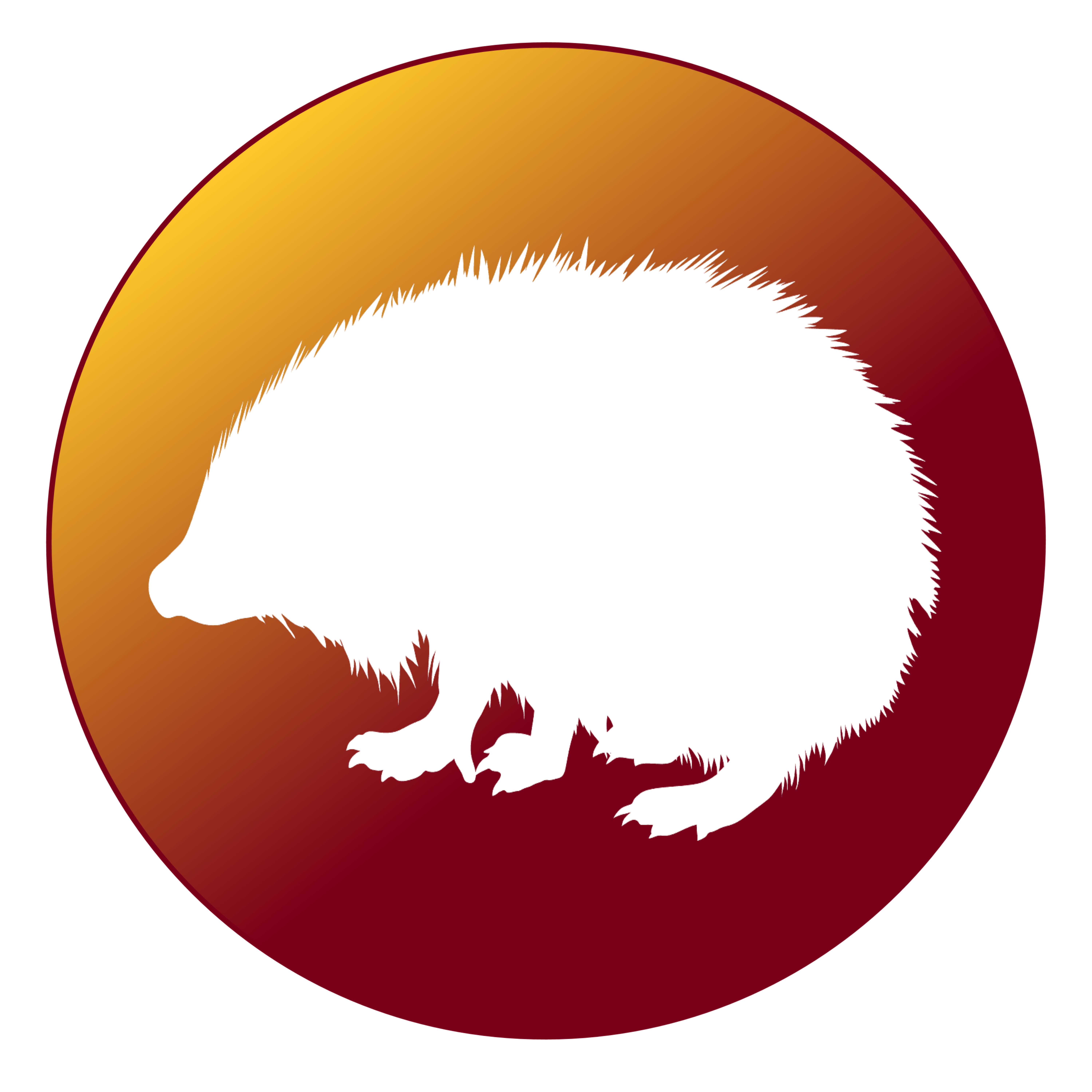 Hedgehogs
Hedgehogs
Ownership of hedgehogs is illegal in the states of Arizona, California, Georgia, Hawaii, Maine, and Pennsylvania and in Washington DC and all five boroughs of New York City.
Unique Anatomy and Biology
Biology of Hedgehogs
| LIFE SPAN | 3-8 years |
| TEMPERATURE | 97-99°F (36-37°C) |
| PULSE | 180-280 beats per minute |
| RESPIRATION | 25-50 breaths/minute |
| REPRODUCTIVE MATURITY | ♀ puberty 6-8 months, ♂ breeding initiation 2-6 months |
The most common hedgehog variety kept as a pet in the United States is descended from African species and is called the African pygmy hedgehog. These animals are 7-10” (18-25.5 cm) long and weigh 9-25 oz (255-708 gm). They have a long snout, four digits on each foot, and 36 teeth. They have unique musculature that permits them to roll into an almost complete ball with the spines facing outwards, for defense.
Appearance of Hedgehogs
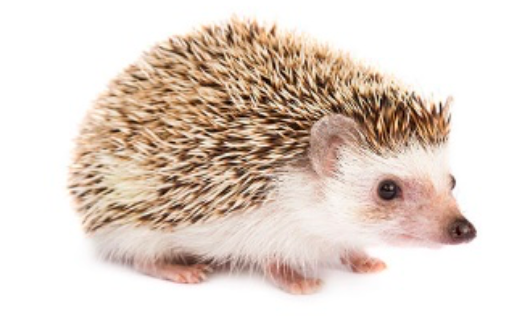 |
The most notable characteristic of hedgehogs are the spines that the animal has developed as a means of defense. The spines cover the back, sides, and the crown of the head; the face, forehead, chest and underside are covered with hair. The spines are modified hairs made of keratin. Each hedgehog has from 5,000 to 7,000 spines. The outside of the spine is solid and the inside is filled with soft air pockets. Spines are soft at birth and harden within hours, with an even stiffer set of spines emerging at about 2 days of age.
Sex identification is by anogenital distance. The genitals of the female are adjacent to the anus while the penis of the male is well away from the anus, on the ventral midline, and often looks like a big belly button.
Sex Identification of Hedgehogs
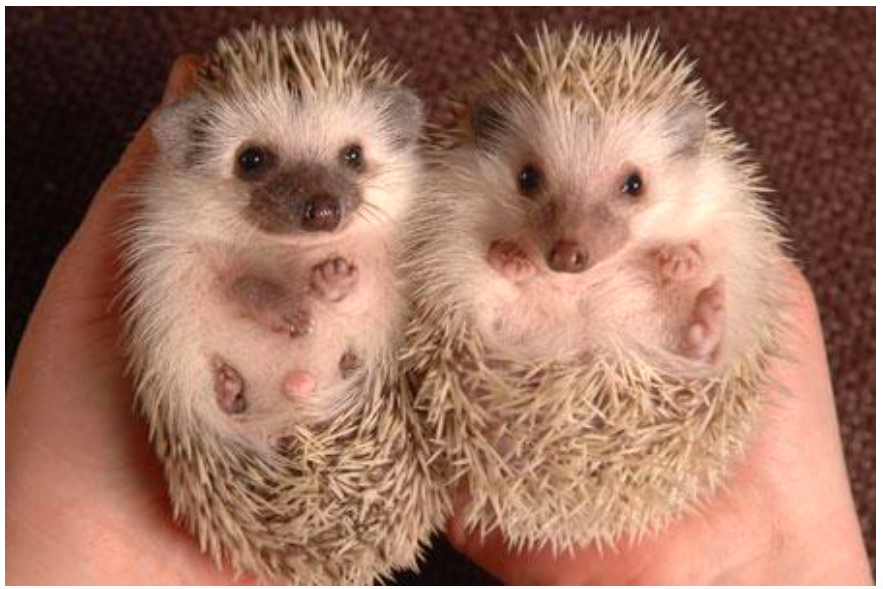
Specifics of anatomy and other information about hedgehogs can be found in the Manual of Exotic Pet Practice, pp 433-455.
Housing
Hedgehogs are best housed individually. Aquariums, large plastic tubs, and plastic dog or cat carriers can be used as enclosures for hedgehogs. The enclosure should have smooth, high walls and a lid to prevent escape. Larger habitats are recommended to allow room for a litter pan, nest box, and exercise wheel, and to give the hedgehog room for exercise; in the wild, hedgehogs wander long distances in search of food and mates. A nest / sleeping box should be provided for the hedgehog. It should be a little longer, wider, and taller than the animal. The animal should be able to enter, turn around, and exit the box easily. Aspen or other non-aromatic shavings are recommended as a floor covering and should be changed 1-2 times weekly. Sawdust may cause respiratory problems and it can also cling to the anal and genital areas of the animal. The cage should have a solid floor. Hedgehogs can injure their legs and feet if they get caught in wire floors. Hedgehogs are clean animals and prefer to urinate and defecate in a dedicated area. A litter tray should be put in the cage. Plastic is preferred because it’s easy to clean. Non-scoopable, dust-free clay cat litter can be used in the litter box. The litter tray needs to be cleaned daily and the litter should be changed weekly. Food bowls should be sturdy and non-moveable. Hedgehogs should also have a sipper water bottle. Ambient temperature should be 75-80°F. At much lower temperatures, hedgehogs will hibernate and at much higher temperatures, they estivate.
Vaccinations and Disease Control
There are no vaccines recommended for control of infectious disease in pet hedgehogs.
Parasite Control
The most common parasite of pet hedgehogs is mites. Animals may carry the mites with no signs or may show pruritus and quill loss. Diagnosis is by microscopic examination of skin scrapings and treatment is with ivermectin or permethrins.
Behavior
Pet hedgehogs generally are most active at dawn and dusk; in the wild, hedgehogs are nocturnal. Hedgehogs are solitary. They make a variety of sounds including clicking and hissing, and make and hear sounds well above the range of human hearing. One of the most peculiar and least understood behaviors of the hedgehog is the process of anointing. When the animal comes across a new smell or object, it licks at the smell or object, producing a flow of foamy saliva. The animal will then stiffen its front legs and swing its head from side to side. Using its tongue it spits and smears its spines with the saliva. The reason for the behavior is not known. Enrichment is an important component of housing to promote normal behaviors.
Biosecurity
The Center for Disease Control and Prevention reported an outbreak of salmonellosis in humans in 2019 that was traced back to hedgehogs. No single supplier of pet hedgehogs was identified as problematic. The CDC strongly encourages people to wash their hands after handling a hedgehog and any of its toys or anything in its enclosure. Never put a hedgehog near the face or kiss a hedgehog. The very young, and very old, and immunosuppressed people are at greatest risk of infection.
Nutrition
Nutritional requirements of hedgehogs have not been well defined. The base of the diet for captive hedgehogs should be a commercial insectivore diet for their species or dry, low-calorie cat or dog food. Other foods that can be provided include invertebrates such as earthworms, mealworms, waxworms; crickets; vegetables such as spinach, kale, carrots, and yams; fruits such as apples, bananas, papayas, and melon; and occasional treats of cooked egg, or meat baby food. Caution must be used to ensure hedgehogs do not become obese. Foods that should not be given to hedgehogs include grapes, raisins, onion, garlic, and dairy products.

*
 Sugar Gliders
Sugar Gliders
Sugar gliders are not legal to keep as pets in Alaska and California. Special permits are required for ownership in Massachusetts and Pennsylvania.
Unique Anatomy and Biology
Biology of Sugar Gliders
| LIFE SPAN | 12-15 years |
| TEMPERATURE | 96.5-98.0°F (36-37°C) |
| PULSE | 200-300 beats per minute |
| RESPIRATION | 16-40 breaths/minute |
| REPRODUCTIVE MATURITY | ♀ and ♂ puberty 3-4 months |
The total body length is 10-12” (25-30 cm). The tail is usually equal to the body length. They weigh 3-5 oz (85-140 gm) with males being slightly larger than females. They have a triangular head with a short muzzle, rounded nose, and large eyes. They are soft gray in color with cream undersides. Sugar gliders have five toes on each forefoot which end with short curved claws. The inner toe on the hind foot is clawless but enlarged or bulbous which helps them grasp and hold on to branches. The second and third digits on the rear feet are fused together and have two claws.
One of the most distinguishing features of the sugar glider is the patagium, a thin, furred membrane that stretches from the wrists to the ankles. When not gliding, the membrane appears as excess skin on the side of the animal. When gliding the animal extends all four legs, which stretches the membrane out and allows the animal to glide up to 150 ft.
Appearance of a Sugar Glider
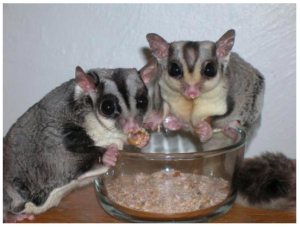 |
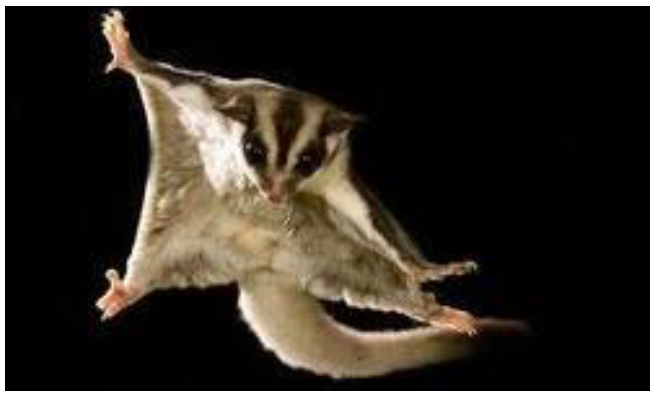 |
Male sugar gliders have a scrotum on their midline. The penis is bifurcated but is rarely seen extruded. Adult males have a distinctive diamond-shaped bald spot on top of their head which corresponds to a scent gland. Females have a small pouch, which appears as a ½” slit, on their abdomen.
Housing
The enclosure needs to be large enough to house more than one animal and to allow them to explore, climb, exercise, and glide. Large bird cages or aviaries may be used for housing sugar gliders. To prevent escape, the openings between wire bars should be quite small, especially if babies are present.
Tree branches or limbs should be added to give the cage a more natural environment and to encourage foraging and exercise. Branches from non-toxic woods like apple, pear, plum, or willow are recommended; conifer branches should not be used.
Cages should include a nest box and safe bedding. A cloth pouch high in the cage will be used as a place to curl up and rest. Aromatic wood shavings should not be used for bedding. Toys used for birds like swings, ladders, and bells can be enjoyed by sugar gliders. They also like pieces of PVC pipe or cardboard paper towel rolls for exploring.
Food should be placed in heavy bowls that can’t be tipped over. Water can be supplied in heavy bowls or bird dishes fastened to the side of the cage. Bowls need to be cleaned daily. Food bowls should be placed high up in the cage where the gliders will feel more safe and secure. This also will prevent feces and urine from falling into them and contaminating the contents.
Ambient temperature should be 64-75°F at a minimum. At temperatures greater than 88°F, sugar gliders may suffer from hyperthermia.

Vaccinations and Disease Control
There are no vaccines recommended for control of infectious disease in pet sugar gliders.
Parasite Control
Parasitism is uncommon in pet sugar gliders.
Behavior
Sugar gliders are nocturnal and are very sociable, doing best if housed in groups of at least two. Behavior disorders such as over-grooming with subsequent fur loss, self-injury, pacing, and changes in appetite can occur in sugar gliders housed alone, with incompatible mates, or in inappropriate cages. Enrichment is an important component of housing to promote normal behaviors.
Biosecurity
Good general hygiene should offset any concerns about passage of disease from pet sugar gliders to humans.
Nutrition
Sugar gliders are omnivores. It is difficult to replicate the diet they would have in the wild. Commercial diets are available. Sweet foods are preferred by the animal and it is not advisable to have sweet food available at all times, as other foods may then not be eaten as necessary. For protein, sugar gliders can be provided with about 1 tablespoon of insects or cooked lean meat daily. Up to ½ teaspoon of chopped fruits and vegetables can be offered for a short time late in the day; good choices include apples, bananas, grapes, kiwi fruit, oranges, melon, papayas, sweet potatoes, tomatoes, corn, carrots, squash, and broccoli. Sugar gliders should not be fed insects or worms collected and brought in from outside, which may be contaminated with pesticides, apple seeds or fruit pits, and anything high in fat or sugar, such as chocolate.

*
 Extra Resources
Extra Resources
- Common disorders of ferrets: http://www.merckvetmanual.com/exotic-and-laboratory-animals/ferrets
- Common disorders of rabbits: http://www.merckvetmanual.com/exotic-and-laboratory-animals/rabbits
- Common disorders of hedgehogs: http://www.merckvetmanual.com/exotic-and-laboratory-animals/hedgehogs/diseases-of-hedgehogs
- Common disorders of sugar gliders: http://www.merckvetmanual.com/exotic-and-laboratory-animals/sugar-gliders/diseases-and-syndromes-of-sugar-gliders
- The American Ferret Association – colors and patterns of ferrets: http://www.ferret.org/pdfs/Ferret_Colors_and_Patterns.pdf
- The American Ferret Association – ferret health and disease: http://www.ferret.org/readmenu.html
- American Rabbit Breeders Association: https://www.arba.net/breeds.htm
- House Rabbit Society: http://rabbit.org/
- International Hedgehog Association (IHA): http://hedgehogclub.com/
- Association of Sugar Glider Veterinarians – owner education materials: http://www.asgv.org/pet_owners/
- The Manual of Exotic Pet Practice: http://www.sciencedirect.com/science/book/9781416001195

